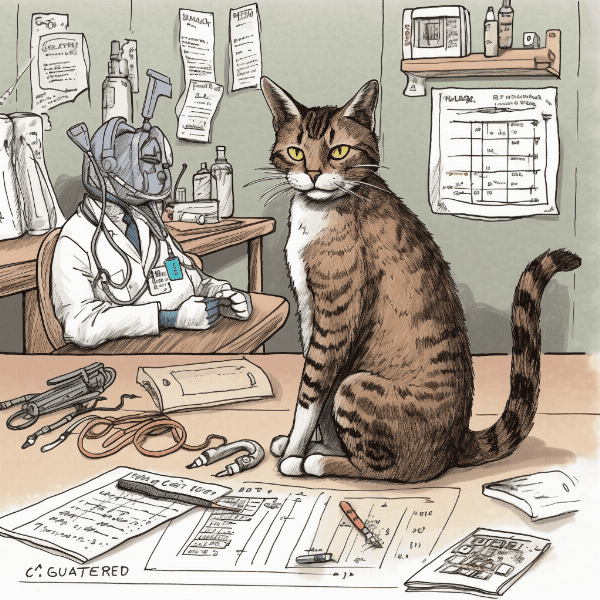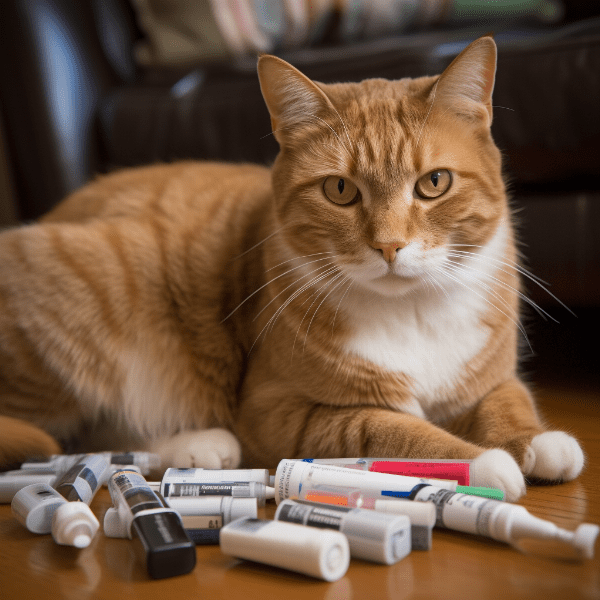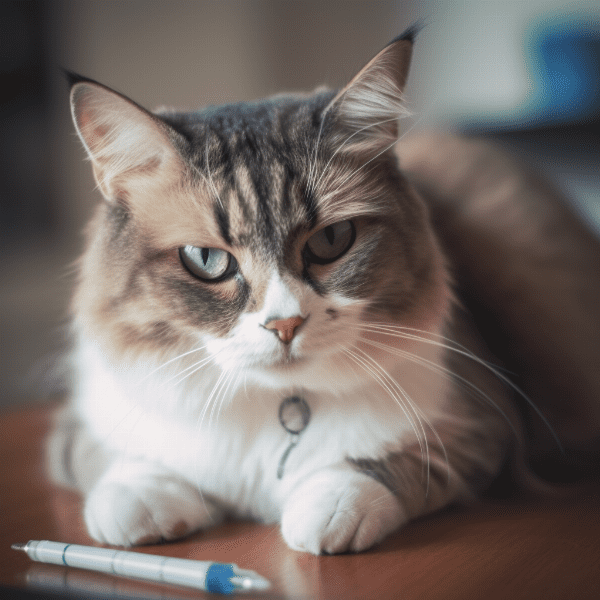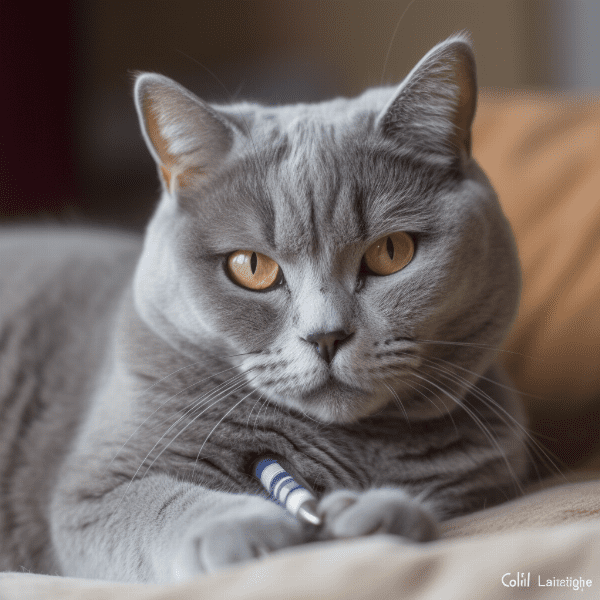Table of Contents
- Understanding Feline Diabetes: Symptoms and Causes
- Diagnosis of Feline Diabetes: Tests and Examinations
- Importance of Diet in Feline Diabetes Management
- Insulin Therapy for Feline Diabetes: Types and Administration
- Monitoring Feline Diabetes: Blood Glucose Testing and Recording
- Alternative Therapies for Feline Diabetes: Pros and Cons
- Preventing Feline Diabetes: Tips for Pet Owners
- Coping with Feline Diabetes: Emotional and Financial Considerations
- Potential Complications of Feline Diabetes: Risks and Precautions
- Living with Feline Diabetes: Success Stories and Community Support.
Understanding Feline Diabetes: Symptoms and Causes
Feline diabetes is a chronic condition that affects the way a cat’s body metabolizes glucose, resulting in high blood sugar levels. This occurs when the pancreas does not produce enough insulin, or when the body becomes resistant to the insulin it produces.
Symptoms of Feline Diabetes
Early detection of feline diabetes is essential for proper treatment and management. Some common symptoms of feline diabetes include:
- Increased thirst and urination
- Weight loss despite increased appetite
- Lethargy and weakness
- Vomiting and diarrhea
- Inability to jump or climb stairs
- Poor coat condition
If you notice any of these symptoms in your cat, it is essential to consult your veterinarian immediately. Ignoring these symptoms can lead to serious complications, such as diabetic ketoacidosis, which can be life-threatening.
Causes of Feline Diabetes
Several factors can contribute to the development of feline diabetes, including genetics, obesity, and age. Some breeds of cats, such as Burmese, Abyssinian, and Siamese, are more prone to developing diabetes.
Obesity is a significant risk factor for feline diabetes, as excess body fat can cause insulin resistance, making it more challenging for the body to regulate blood sugar levels.
Lastly, age also plays a role in the development of feline diabetes. Older cats, especially those over 10 years old, are at a higher risk of developing the condition.
In conclusion, understanding the symptoms and causes of feline diabetes is essential for pet owners to ensure early detection and proper management of the condition. If you suspect that your cat has diabetes, consult your veterinarian immediately to prevent any complications and improve the quality of life for your furry companion.

Diagnosis of Feline Diabetes: Tests and Examinations
Diagnosing feline diabetes requires a combination of clinical signs, physical examinations, and laboratory tests. Your veterinarian will perform several tests and examinations to determine if your cat has diabetes and the severity of the condition.
Clinical Signs and Physical Examination
During the initial examination, your veterinarian will ask about your cat’s medical history, including any symptoms or changes in behavior. They will also perform a physical examination to check for signs of diabetes, such as dehydration, weight loss, and an enlarged liver.
Blood Glucose Testing
Blood glucose testing is the most crucial diagnostic tool for feline diabetes. Your veterinarian may perform several blood glucose tests to confirm the diagnosis. The most common tests are:
- Fasting Blood Glucose Test: Your cat will need to fast for at least 8 hours before the test, and blood will be drawn to check the glucose levels. A blood glucose level of 126 mg/dL or higher indicates diabetes.
- Fructosamine Test: This test measures the average blood glucose levels over the past few weeks. This test is especially helpful in cats who have high stress levels during blood draws.
- Glucose Tolerance Test: This test involves administering glucose to your cat and monitoring blood glucose levels at specific intervals. This test is helpful in determining how well your cat’s body is processing glucose.
Urine Analysis
Your veterinarian may also perform a urine analysis to check for the presence of glucose in the urine. If glucose is present, it may indicate that your cat has diabetes.
Additional Tests
In some cases, your veterinarian may perform additional tests to check for complications or underlying conditions. These tests may include a complete blood count, chemistry panel, thyroid test, and urinalysis.
In conclusion, proper diagnosis of feline diabetes requires a combination of clinical signs, physical examinations, and laboratory tests. Early detection of feline diabetes is essential for proper treatment and management, and if you suspect that your cat has diabetes, it is crucial to consult your veterinarian immediately.

Importance of Diet in Feline Diabetes Management
Diet plays a crucial role in managing feline diabetes. Proper nutrition can help regulate blood glucose levels, prevent complications, and improve overall health. In this section, we will discuss the importance of diet in feline diabetes management and the best dietary options for cats with diabetes.
Nutritional Requirements
Cats with diabetes require a well-balanced diet that meets their nutritional requirements while also managing their blood glucose levels. A diet that is high in protein, low in carbohydrates, and low in fat is ideal for cats with diabetes.
Commercial Diets
Several commercial diets are available that are specifically formulated for cats with diabetes. These diets are high in protein and fiber, and they have a low glycemic index, which helps regulate blood glucose levels. Some commercial diets may also contain supplements that help manage diabetes, such as chromium and arginine.
Home-Cooked Diets
If you prefer to prepare your cat’s food at home, it is crucial to work with a veterinary nutritionist to ensure that the diet is nutritionally balanced and appropriate for your cat’s specific needs. Home-cooked diets for cats with diabetes typically include high-protein sources such as chicken, fish, and eggs, along with fiber-rich vegetables.
Feeding Schedule
Feeding schedule also plays a crucial role in managing feline diabetes. It is recommended to feed your cat small, frequent meals throughout the day, rather than one or two large meals. This helps regulate blood glucose levels and prevents sudden drops or spikes.
Treats and Snacks
Treats and snacks can be a part of your cat’s diet, but it is essential to choose low-carbohydrate options and to limit the amount. Some suitable options include small pieces of cooked chicken, fish, or meat, or low-carbohydrate cat treats.
In conclusion, diet is a critical component of feline diabetes management. Feeding a well-balanced, high-protein, low-carbohydrate diet, and feeding small, frequent meals throughout the day can help regulate blood glucose levels and improve overall health. If you have any concerns about your cat’s diet, consult your veterinarian or a veterinary nutritionist for guidance.

Insulin Therapy for Feline Diabetes: Types and Administration
Insulin therapy is the cornerstone of feline diabetes management. Insulin is administered to replace the insulin that the cat’s body is not producing, or not producing enough of, and to help regulate blood glucose levels. In this section, we will discuss the types of insulin used for feline diabetes, how it is administered, and important considerations for insulin therapy.
Types of Insulin
There are several types of insulin used in feline diabetes management, including:
- Regular insulin: This type of insulin is short-acting and typically administered two to three times a day.
- Intermediate-acting insulin: This type of insulin lasts longer than regular insulin and is usually given once or twice a day.
- Long-acting insulin: This type of insulin lasts up to 24 hours and is typically given once a day.
The type of insulin used and the dosage will depend on the severity of the cat’s diabetes and their individual needs.
Insulin Administration
Insulin is typically administered by injection under the skin, known as subcutaneous injection. The injection site should be rotated with each dose to prevent skin irritation and to ensure proper absorption. Your veterinarian will demonstrate how to administer insulin and will provide specific instructions based on the type of insulin used and your cat’s individual needs.
Important Considerations
Insulin therapy requires careful monitoring to ensure that the dosage is appropriate and that blood glucose levels are well-regulated. Regular blood glucose testing is necessary to determine the appropriate insulin dosage and to detect any changes in blood glucose levels. Your veterinarian may also recommend monitoring your cat’s weight, food intake, and water consumption.
It is essential to follow your veterinarian’s instructions carefully, and to never adjust the insulin dosage or schedule without consulting them first. Changing the insulin dosage or schedule can have severe consequences and can lead to complications, such as hypoglycemia, which can be life-threatening.
In conclusion, insulin therapy is a crucial component of feline diabetes management. It is essential to work closely with your veterinarian to determine the appropriate insulin dosage and schedule, and to monitor your cat’s blood glucose levels regularly. With proper insulin therapy and monitoring, cats with diabetes can live long, healthy lives.

Monitoring Feline Diabetes: Blood Glucose Testing and Recording
Regular monitoring of blood glucose levels is essential for the management of feline diabetes. Monitoring helps to ensure that insulin therapy is working correctly and that blood glucose levels are well-regulated. In this section, we will discuss the importance of monitoring blood glucose levels, how to test blood glucose levels, and how to record the results.
Importance of Monitoring Blood Glucose Levels
Monitoring blood glucose levels is essential to determine the effectiveness of insulin therapy and to detect any changes in blood glucose levels. Regular monitoring can help prevent complications, such as diabetic ketoacidosis, which can be life-threatening.
How to Test Blood Glucose Levels
There are several methods for testing blood glucose levels in cats, including:
- Blood glucose meters: These meters are similar to those used by humans with diabetes and require a small sample of blood, usually obtained by pricking the cat’s ear or paw.
- Continuous glucose monitoring: This involves implanting a small device under the cat’s skin, which measures blood glucose levels continuously. This method is less invasive than traditional blood glucose testing but may be more expensive.
Your veterinarian will recommend the best method for testing blood glucose levels based on your cat’s individual needs.
Recording Blood Glucose Results
It is essential to record blood glucose test results to monitor trends over time and to detect any changes in blood glucose levels. A blood glucose logbook should include the date and time of the test, the blood glucose level, and any notes about changes in diet, insulin dosage, or other factors that may affect blood glucose levels.
Your veterinarian may also recommend bringing the blood glucose logbook to each visit to help assess the effectiveness of insulin therapy and make any necessary adjustments.
In conclusion, monitoring blood glucose levels is essential for the management of feline diabetes. Regular testing and recording of results can help detect any changes in blood glucose levels and prevent complications. If you have any questions about monitoring your cat’s blood glucose levels, consult your veterinarian for guidance.

Alternative Therapies for Feline Diabetes: Pros and Cons
In addition to insulin therapy and diet management, there are several alternative therapies that may be helpful in managing feline diabetes. In this section, we will discuss the pros and cons of alternative therapies, including acupuncture, herbal remedies, and homeopathy.
Acupuncture
Acupuncture involves the insertion of thin needles into specific points on the body to stimulate nerves, muscles, and connective tissues. Acupuncture may help improve blood glucose levels, decrease inflammation, and reduce stress in cats with diabetes.
- Acupuncture is non-invasive and has few side effects.
- Some studies suggest that acupuncture may be helpful in managing feline diabetes.
- Acupuncture may not be effective for all cats with diabetes.
- Multiple treatments may be required, which can be expensive.
Herbal Remedies
Several herbal remedies, such as ginseng and cinnamon, are believed to help regulate blood glucose levels in cats with diabetes.
- Herbal remedies may be helpful in managing blood glucose levels in some cats with diabetes.
- They are often less expensive than traditional medications.
- Herbal remedies may interact with other medications, causing adverse effects.
- The efficacy of herbal remedies is not well-studied in cats, and there is a lack of regulation in the manufacturing and labeling of these products.
Homeopathy
Homeopathy is a form of alternative medicine that uses highly diluted substances to stimulate the body’s natural healing process. Homeopathy may be used to manage feline diabetes by improving overall health and vitality.
- Homeopathy is non-invasive and has few side effects.
- Some homeopathic remedies may be helpful in managing feline diabetes.
- The efficacy of homeopathy is not well-studied in cats, and there is a lack of regulation in the manufacturing and labeling of these products.
- Homeopathy should not be used as a replacement for insulin therapy or other traditional treatments.
In conclusion, alternative therapies may be helpful in managing feline diabetes, but they should be used in conjunction with traditional treatments, such as insulin therapy and diet management. Consult with your veterinarian before using any alternative therapies to ensure their safety and effectiveness for your cat’s individual needs.

Preventing Feline Diabetes: Tips for Pet Owners
Preventing feline diabetes is crucial for maintaining your cat’s health and quality of life. In this section, we will discuss tips for pet owners to help prevent feline diabetes.
Maintain a Healthy Weight
Obesity is a significant risk factor for feline diabetes. To prevent obesity, ensure that your cat is eating a well-balanced diet that meets their nutritional needs and is appropriate for their age, breed, and activity level. Avoid overfeeding and provide plenty of opportunities for exercise and play.
Regular Veterinary Check-Ups
Regular veterinary check-ups are essential for detecting any signs of feline diabetes early. Your veterinarian can perform routine blood glucose testing and physical examinations to assess your cat’s overall health and make any necessary recommendations for preventative care.
Avoid High-Carbohydrate Foods
High-carbohydrate foods, such as dry kibble, can increase the risk of feline diabetes. Choose a diet that is high in protein, low in carbohydrates, and low in fat to help prevent feline diabetes.
Manage Stress
Stress can also contribute to the development of feline diabetes. Provide a comfortable and stimulating environment for your cat, and ensure that they have plenty of opportunities for play and relaxation.
Regular Exercise
Regular exercise can help maintain a healthy weight and prevent obesity, which is a significant risk factor for feline diabetes. Provide plenty of opportunities for exercise, such as playing with toys or going for walks on a leash.
In conclusion, preventing feline diabetes requires a combination of proper nutrition, regular veterinary check-ups, and preventative care. Maintaining a healthy weight, avoiding high-carbohydrate foods, managing stress, and regular exercise can all help prevent feline diabetes and improve your cat’s overall health and quality of life. If you have any concerns about your cat’s health, consult your veterinarian for guidance.

Coping with Feline Diabetes: Emotional and Financial Considerations
Coping with feline diabetes can be challenging for both pet owners and their cats. In addition to the physical aspects of managing diabetes, there are also emotional and financial considerations. In this section, we will discuss coping with feline diabetes from both emotional and financial perspectives.
Emotional Considerations
It is also essential to maintain a positive attitude and focus on the positive aspects of caring for your cat. With proper care and management, cats with diabetes can live long, healthy lives.
Financial Considerations
Managing feline diabetes can also be expensive. The cost of insulin, blood glucose testing supplies, and veterinary visits can add up quickly. It is essential to budget for the cost of managing feline diabetes and to consider options such as pet insurance or financial assistance programs.
Some organizations offer financial assistance for pet owners who are struggling to pay for veterinary care. Your veterinarian may also be able to provide guidance on affordable options for managing feline diabetes.
In conclusion, coping with feline diabetes requires both emotional and financial considerations. It is essential to take care of your own emotional well-being and to seek support when needed. Budgeting for the cost of managing feline diabetes and considering options for financial assistance can also be helpful. With proper care and management, cats with diabetes can live long, healthy lives.

Potential Complications of Feline Diabetes: Risks and Precautions
Feline diabetes is a chronic condition that requires ongoing management to prevent complications. In this section, we will discuss potential complications of feline diabetes and precautions that pet owners can take to minimize these risks.
Diabetic Ketoacidosis
Diabetic ketoacidosis is a potentially life-threatening complication of feline diabetes. It occurs when the body breaks down fat for energy instead of glucose, resulting in the buildup of toxic acids in the blood. Symptoms of diabetic ketoacidosis include vomiting, lethargy, and loss of appetite.
- Regular monitoring of blood glucose levels and insulin therapy can help prevent diabetic ketoacidosis.
- Seek veterinary care immediately if you notice any symptoms of diabetic ketoacidosis in your cat.
Hypoglycemia
Hypoglycemia is a condition in which blood glucose levels drop too low, causing weakness, tremors, and seizures. Hypoglycemia can occur if the insulin dosage is too high or if the cat does not eat enough.
- Regular monitoring of blood glucose levels can help detect any changes in blood glucose levels and prevent hypoglycemia.
- Never adjust the insulin dosage or schedule without consulting your veterinarian first.
Urinary Tract Infections
Urinary tract infections are more common in cats with diabetes because the high glucose levels in the urine provide a breeding ground for bacteria. Symptoms of urinary tract infections include frequent urination, straining to urinate, and blood in the urine.
- Regular veterinary check-ups can help detect any signs of urinary tract infections early.
- Maintain proper hygiene by keeping the litter box clean and providing plenty of opportunities for your cat to drink water.
Neuropathy
Neuropathy is a condition in which nerve damage occurs, causing weakness and muscle wasting in the hind legs. Neuropathy is more common in cats with uncontrolled diabetes.
- Regular monitoring of blood glucose levels and insulin therapy can help prevent neuropathy.
- If your cat develops neuropathy, your veterinarian may recommend physical therapy or other treatments to help improve muscle function.
In conclusion, feline diabetes requires ongoing management to prevent complications. Regular monitoring of blood glucose levels, insulin therapy, and preventative care can help minimize the risk of complications such as diabetic ketoacidosis, hypoglycemia, urinary tract infections, and neuropathy. Consult with your veterinarian for guidance on managing your cat’s diabetes and preventing complications.

Living with Feline Diabetes: Success Stories and Community Support.
Living with feline diabetes can be challenging, but there are many success stories and community support resources available to pet owners. In this section, we will discuss some success stories and community support options for pet owners living with feline diabetes.
Success Stories
Many cats with diabetes live long, healthy lives with proper management and care. With regular veterinary check-ups, blood glucose monitoring, and insulin therapy, cats with diabetes can maintain good health and quality of life.
Pet owners who have successfully managed their cat’s diabetes often share their experiences and tips with others. These success stories can provide inspiration and hope for pet owners who may be feeling overwhelmed or discouraged.
Community Support
There are many online communities and support groups for pet owners living with feline diabetes. These communities provide a platform for pet owners to connect, share their experiences, and offer support and advice to others.
The American Animal Hospital Association (AAHA) offers a diabetes management program that provides resources and support for pet owners managing feline diabetes. The program includes an online forum, educational materials, and a directory of AAHA-accredited veterinary clinics.
In addition, many veterinary clinics offer diabetes support groups and educational resources for pet owners.
Emotional Support
Managing feline diabetes can be emotionally taxing for pet owners. It is essential to take care of your own emotional well-being by seeking support from friends, family, or support groups. Talking to other pet owners who are going through a similar experience can be helpful.
Pet therapy and emotional support animals can also provide comfort and support to pet owners living with feline diabetes.
In conclusion, living with feline diabetes requires ongoing management and care, but there are many success stories and community support options available to pet owners. By staying informed, seeking support, and maintaining a positive attitude, pet owners can provide their cats with the best possible care and quality of life.




